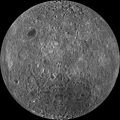Far side of the Moon
| Advanced search |
- About 5 results found and you can help!
 Far side of the Moon, photographed by Apollo 16 |
The far side of the Moon, sometimes called the "dark side of the Moon" in the sense that it is in a radio blackout in respect to transmitters on Earth, is the lunar hemisphere that is permanently turned away, and not visible from the surface of the Earth. The far hemisphere was first photographed by the Soviet Luna 3 probe in 1959, and was first directly observed by human eyes when the Apollo 8 mission orbited the Moon in 1968. The rugged terrain is distinguished by a multitude of crater impacts, as well as relatively few lunar maria. It includes the second largest known impact feature in the Solar System, the South Pole-Aitken basin. The far side has been suggested as a potential location for a large radio telescope, as it would be shielded from possible radio interference from Earth. To date, there has been no ground exploration of the far side of the Moon.
- See also: Wikipedia
- Related: Near side of the Moon, Geology of the Moon, South Pole – Aitken basin, Giant impact hypothesis
| Lunar and Planetary Institute: Exploring the Moon Lunar and Planetary Institute: Exploring the Moon www.lpi.usra.edu/expmoon/ - Web |
| Lunar and Planetary Institute: Lunar Atlases Lunar and Planetary Institute: Lunar Atlases www.lpi.usra.edu/resources/lunar_atlases/ - Web |
| Ralph Aeschliman Planetary Cartography and Graphic... Ralph Aeschliman Planetary Cartography and Graphics: Lunar Maps ralphaeschliman.com/id26.htm - Web |
Gallery for «Far side of the Moon»
Average relevance
| Northwest Africa 482, only meteorite believed to h... Northwest Africa 482, only meteorite believed to have originated from the far side of the Moon www.catchafallingstar.com - Web |
| Moon articles in Planetary Science Research Discov... Moon articles in Planetary Science Research Discoveries www.psrd.hawaii.edu/Archive/Archive-Moon.html - Web |


